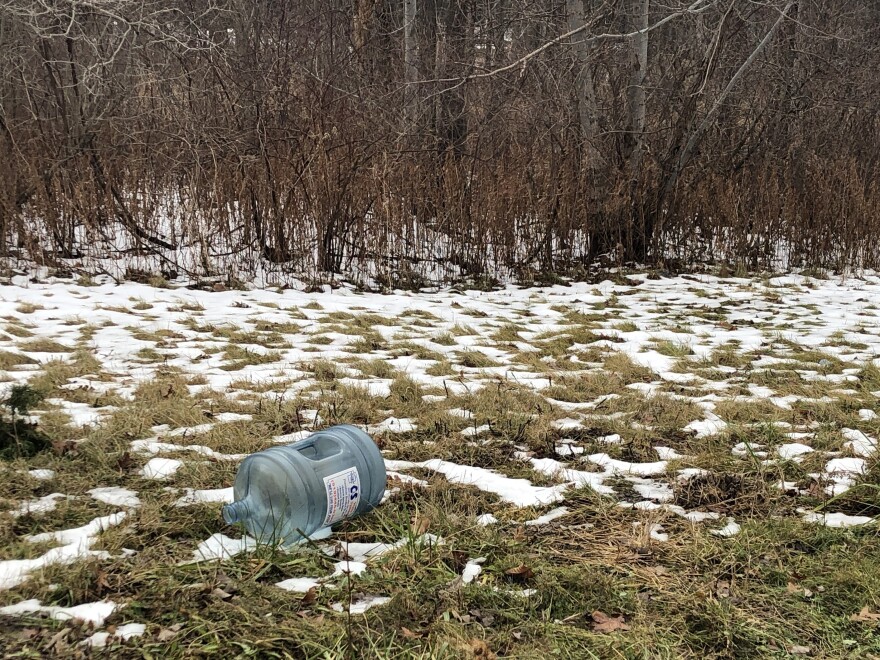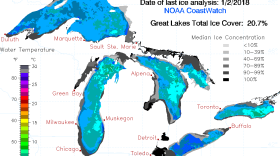Part 3 in a series on environmental justice issues in the Great Lakes region.
At the Six Nations of the Grand River reserve, about 10 men are gathered in a classroom in the Haudenosaunee community center. The older men are teaching younger ones some traditions – on this day, they’re learning about a funeral ritual. But soon, Leroy Hill shifts the conversation to a new topic – water.
“Is there anybody here who don’t have to either buy water or get it hauled?” Hill asks. After a few responses, he sums them up: “We’re all buying water.”
Some of the men in this Ontario community have contaminated water wells in their backyards. Some have wells without water, and others don’t drink the water at all out of fear.
For 18 years, Six Nations has had a boil water advisory in place for residents who rely on well water. So, folks have to get their water in other ways – a station in the center of town to fill jugs or tanks, or paying to have water delivered.
Col Martin pays $80 every two months to fill his cistern. Dave Williams buys bottled water.
“You can’t just go to the tap and turn it on and drink it,” Williams says. “You can’t do that, you can’t take that chance.”
Contaminated drinking water is a big problem for Canada’s indigenous communities, known as First Nations.
There are currently 67 long-term advisories, designed to protect residents from bacteria like E. coli and other harmful contaminants. In some communities, the Canadian government warns residents not to use the water at all – even for washing up.
In 2016, the government announced a new initiative and a plan to remove all advisories by 2021, in addition to repairing and replacing water treatment facilities.
“We would like to see as fast as possible, and we are committed to supporting First Nations as quickly as possible, recognizing that infrastructure does take some time to be implemented.” says Lysane Bolduc of Indigenous Services Canada.
Hill says his ancestors fought for this territory and the community deserves better treatment from Canadian officials.
“The government said we’ll manage it and we’ll provide your services – that’s the agreement,” Hill says. “They’re doing a piss poor job.”
The Canadian government has pledged $1.8 billion to resolve the First Nations problem.
But Six Nations’ experience shows it’s not an easy fix.
In 2013, a new $41 million water treatment plant opened in the community. That provided the capacity to serve the whole community – half of its 27,000 members live on reserve.
Operators went from producing 12 liters a second to 50. But there’s one-part missing – the customers.
“That stat is about 9 percent of our population, then, is serviced directly from the water treatment plant,” says Six Nations Public Works Director Michael Montour.
The cost of connecting the entire community to the plant is $200 million. And that probably won't happen anytime soon because the problem across Canada is so enormous.
Some First Nations don’t even have a water treatment plant, so they’re a higher priority for government funding.
“There’s over 600 First Nations in Canada, over 130 in Ontario, so once that actually trickles down, that’s not a big number,” Montour says. “It’s not what’s needed.”
Montour says he has an application in to receive more funding for infrastructure expansion as well as money to maintain the water treatment plant.
In the meantime, a new project that may shed some light on other water quality issues in Six Nations.
It’s led by McMaster University professor Dawn Martin-Hill. As a resident of the Six Nations reserve, Hill has lived with water problems. The project will figure out what contaminates water sources here – and how to solve long-standing problems.
“I think Americans and Canadians are now going to understand in the very short, near future why they shouldn’t be taking water for granted,” Martin-Hill says. “It’s blue gold.”
The project has funding for three years, but Martin-Hill wants the project to continue after that. She’s already received requests for help from other indigenous communities.
“I don’t want this just to be another report sitting somewhere,” she says. “I want an institute of young people who can continue to carry the work on, train young scientists, learn traditional knowledge, and engage youth.”








